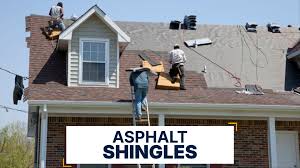Asphalt shingles, the most popular roofing material in Florida, are facing increasing scrutiny after a recent study showed they may not offer sufficient protection against hurricane winds, raising alarms for millions of homeowners in the state.
According to Michael Yaworsky, Commissioner of the Florida Office of Insurance Regulation, 10-year-old asphalt shingle roofs cannot withstand winds of 100 mph or higher. He shared this concern with the Senate Banking and Insurance Committee on Tuesday. Additionally, a representative from the insurance industry-funded construction study group reiterated this point.
Michael Newman, General Counsel for the Insurance Institute for Business & Home Safety, explained, “At 60 mph winds, there’s a one-in-12 chance of damage to a 10-year-old asphalt shingle roof. But at 90 mph winds, the risk jumps to a 25% chance of damage, and at 100 mph winds, nearly 100% of the roof will be damaged.”
Florida’s Hurricane History and Roof Vulnerabilities
In the last two decades, Florida has experienced 12 out of 14 hurricanes reaching Category 2 or greater, with wind speeds ranging from 96 mph to 110 mph. These intense winds are too powerful for a decade-old asphalt roof to handle effectively.
Yaworsky raised eyebrows late last year when he suggested that asphalt shingles may no longer be a viable roofing option for Florida homeowners, stating, “Maybe it’s time to start writing them out of the plot in Florida.”
Asphalt Shingles: Affordable but Risky
Asphalt shingles are the most affordable roofing material in the state, covering about two-thirds of Florida homes. However, alternatives such as ceramic or metal tiles come with a significantly higher cost—up to two or three times more than asphalt.
The findings regarding the vulnerability of 10-year-old asphalt shingles contradict what many roofing companies market to Florida homeowners. State Senator Blaise Ingoglia, R-Spring Hill, raised concerns about misleading sales pitches, noting that salespeople often promote asphalt shingles as 40-year solutions, which may not be realistic for Florida’s weather conditions.
“Is there a way to inform consumers to disregard sales claims of a ‘40-year shingle’?” Senator Ingoglia questioned. “That 40-year shingle will not last 40 years in Florida.”
Homeowner Experience: A Shocking Reality
Sandy Molenda, 77, a retired police officer from western Palm Beach County, shared his personal experience with asphalt shingles. Molenda had installed what he was told were 45-year shingles, expecting he would never need to re-roof his home again. However, just 22 years later, his insurance company informed him he needed a new roof within three months, or his insurance would not be renewed.
“I paid extra for 45-year shingles,” Molenda said, recalling the disappointment when he realized that those shingles hadn’t lived up to their advertised lifespan.
Improving Florida’s Roof Regulations and Incentives
The discussion during Tuesday’s committee meeting focused on making homes in Florida more insurable. The state has long been a leader in strengthening building codes to ensure that homes can better withstand hurricane-force winds. However, a 2023 study commissioned by the state legislature suggested room for further improvements.
The study, which was completed in June 2023, evaluated the performance of roofing materials against wind speeds as roofs age. Based on the study’s findings, Yaworsky stated that changes may be coming to the state’s insurance policies, particularly when it comes to the credits homeowners can receive for hurricane-resistant features like metal roofs or impact windows.
Currently, homeowners receive the same credit for installing either an asphalt shingle roof or a metal roof, but Yaworsky indicated that this may change in the future, reflecting the differences in durability between the two materials.
Yaworsky emphasized the importance of roofs in the overall structural integrity of a home, saying, “Roofs are probably the number one fail point. If a roof fails, you’ve lost the house.”
Metal Roofs: A More Durable Alternative
Kevin Guthrie, the chief of Florida’s Division of Emergency Management, also addressed the committee, highlighting the added benefits of metal roofs in disaster situations. He referred to the 2022 Chipola Complex fires in the Panhandle, which burned 3,000 acres and showed the superior performance of metal roofs. “Homes with asphalt shingle roofs caught fire, but those with metal roofs were less likely to ignite, giving firefighters critical extra time to respond,” Guthrie explained.
Conclusion: The Future of Roofing in Florida
As Florida continues to face the threat of intense hurricanes, homeowners may need to reconsider their roofing choices. Asphalt shingles, despite their affordability, may no longer provide the protection needed for Florida’s harsh weather conditions. Homeowners are encouraged to explore more durable alternatives, such as metal roofs, to better safeguard their homes and ensure they remain insurable.
Disclaimer – Our team has carefully fact-checked this article to make sure it’s accurate and free from any misinformation. We’re dedicated to keeping our content honest and reliable for our readers.








